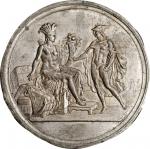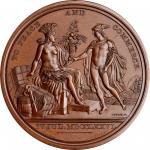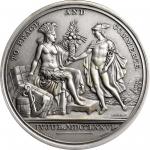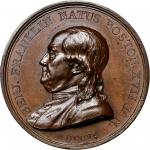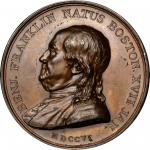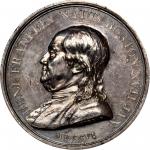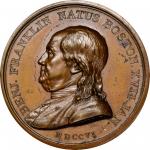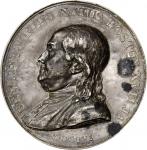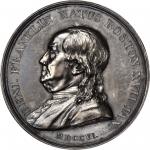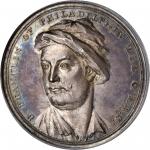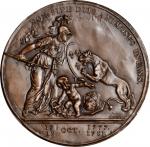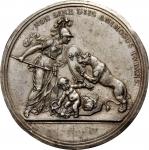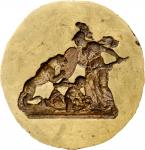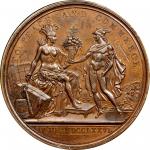"1776" (1792) United States Diplomatic Medal. Loubat-19. Copper. Original. Paris Mint. 68.4 mm. 2414.8 grains. 6.1 - 6.5 mm. Choice About Uncirculated.
Plain edge, unbored. Likely the finest known example of this medal of extraordinary historical importance. Lustrous gloss remains on attractive medium brown surfaces, with faded mint color clinging to devices and legends and pleasing blue highlights across lightly reflective fields. Remarkably well preserved, with just scattered minor ticks and a nick under ERC of COMMERCE. A few light marks on the edge above ME of that word are well hidden from either side, and the rims are otherwise sound. With its smooth originality and exceptional eye appeal, this clearly surpasses both of the other specimens in private hands.
There are only four surviving Diplomatic Medals. One is impounded - the Vermuele specimen at Princeton University - leaving just three in private hands. One of them has an ancient provenance: the Ford specimen, earlier from Colburn (1863) to Bushnell (1882) to Garrett (1981). Another has a short provenance: discovered in Belgium in 2013, auctioned on eBay, sold by John Kraljevich to the Cardinal Collection Educational Foundation, then sold publicly in our Rarities Auction of October 2015 as lot 3 for $188,000. That piece is the only example among the surviving four to retain its original mount. The Ford piece was bored on its edge for a mount. This one was not.
All four surviving specimens of the Diplomatic Medal are from the same die pair, representing the second obverse and the third reverse engraved by Augustin Dupre. The side with the Great Seal of the United States was termed the obverse by all characters involved in the medal's initial production. Perhaps due to the preponderance of similar eagles on the reverses of United States coins, this has been a point of some confusion for American numismatists in more modern times. The first obverse cracked early on, and no impressions have survived, though the die itself is preserved in the Boston Public Library. The second obverse was used to produce all four bronze examples known, and it undoubtedly struck the two gold medals as well. Adams and Bentley record eight different uniface tin cliches from that obverse. The reverses were even more finicky, as the first attempt broke in hardening and yielded just a single tin impression, last offered in our (Stack's) Ford V sale of October 2004. The second reverse die, also in the collection of the Boston Public Library, is said to have cracked during its first use. William Short's letter to Jefferson on November 21, 1791, reports that "the die for the diplomatic medal has again failed under the press. It resisted only so as to take the first impression in silver," a puzzling citation as no silver medals are recorded in any other document of the era, nor have any survived. The Adams and Bentley census lists six uniface tin survivors from this die. The third and final reverse is seen on the four surviving bronze specimens, as well as three tin uniface cliches.
When Carl Zigrosser described the medals of Augustin Dupre in American collections in 1957 for the Proceedings of the American Philosophical Society, he ably narrated the history of this unique medallic endeavor. "The so-called Diplomatic Medal was the last executed by Dupre for the United States," he wrote. "It is so rare as to be almost legendary." He recounted Washington's order of a gold specimen and chain for the Marquis de la Luzerne on April 30, 1790 and his later request for another medal and chain for the Count de Moustier on March 2, 1791. "No further impressions were ordered struck," though, as Zigrosser noted, a few bronze examples are known.
This is the first medallic diplomatic effort the United States ever made, preceding even the George Washington oval Indian Peace medals. Its production bears the fingerprints of our greatest diplomat of the era, Thomas Jefferson, and the greatest medalist of his lifetime, Augustin Dupre. For a solid century, from 1882 and 1981, no original Diplomatic Medal sold publicly or privately. The modern generation of collectors has been blessed with opportunities to obtain one in 1981, 1990, 2004, and 2015. With the other two examples in strong hands, we do not expect another opportunity to acquire an example of this historical landmark to come as quickly next time.
The Diplomatic Medal
Approved by George Washington, influenced by John Adams and William Temple Franklin (grandson of Benjamin), and brought to fruition by Augustin Dupre, the United States Diplomatic medal was the pet project of Thomas Jefferson. Appointed secretary of State by President Washington on September 26, 1789, Jefferson returned home the following month from Paris, where he had been serving as Minister Plenipotentiary to the Court of Louis XVI. The following spring, in April 1790, he hatched a plan to create gifts for diplomats dispatched to the United States, just as the crowned heads of Europe gave symbols of appreciation to the ambassadors assigned to their governments. After receiving approval from President George Washington, Jefferson asked his charge d'affaires in Paris, William Short, to see the project to fruition, suggesting either Duvivier or Dupre as likely authors of the medal, as they "seem to be the best workmen, perhaps the last is the best of the two."
Though well versed in the ways and means of diplomatic gift exchange, Jefferson reached out to William Temple Franklin for advice on the subject. Franklin answered in long form on April 27, 1790. He told Jefferson that "these presents vary as to their nature, consisting either of jewels, plate [i.e. precious metal], tapestry, porcelain, and sometimes money." He also described Benjamin Franklin's gifts to the French Introductor and his assistant, the latter receiving "a rouleau of fifty Louis d'ors," perhaps the earliest reference to a roll of coins yet discovered.
Jefferson apparently wasted no time. The memorandum in the Jefferson papers entitled "Formula for American Presidents to Foreign Diplomats" appears to be the compiled notes Jefferson made after receiving William Temple Franklin's letter, though the memorandum is undated. Jefferson wrote that "our present" should "consist of a gold medal of 30 lines, the metal in which will be worth about 150 dollars and a gold chain of about 850 doll[ars] value, supposing the minister to have stayed here 7 years." He may have shared the notes with Washington in some form, as Washington recorded in his diary on April 29, 1790, that he had "fixed with the Secretary of State on the present which (according to the custom of other Nations) should be made to Diplomatic characters when they return from that employment in this Country." Apparently inspired by the gift given to John Adams by The Netherlands, Washington recorded that "this was a gold Medal, suspended to a gold Chain -- in ordinary to be of the value of about 120 or 130 guineas." The enormous gold medal Adams received survives, preserved in the collection of the Massachusetts Historical Society. It was further described by Washington as "a medal & chain of the value of, in common, 150 or 180 guineas the value of which to be increased by an additional weight in the chain when they wished to mark a distinguished character," echoing much of the language of Jefferson's memorandum. "The reason why a medal & chain was fixed upon for the American present," Washington wrote, "is, that the die being once made, the medals could at any time be struck at very little cost, & the chain made by our own artisans, which (while the first should be retained as a memento) might be converted into cash."
The day after Washington journaled about his conversation on the subject of diplomatic gifts with his secretary of State, Jefferson filled his inkwell and wrote to both his charge d'affaires in Paris, William Short, and the French ambassador, the Marquis de la Luzerne, to describe the planned medals. The idea was barely hatched, no engraver had been hired, and no gold had been acquired, yet Jefferson could not wait to describe his plan. His rush was ill-advised, however, as no medals would be struck for nearly two years.
Jefferson's casual notes mention three potential recipients of these gold medals for diplomats, namely the Marquis de la Luzerne, the Comte de Moustier, and "Old Mr. Van Berkel" of The Netherlands. Though William Short later recorded receiving just two gold medals for distribution, Adams and Bentley (Comitia Americana and Related Medals, 2007) used Jefferson's early memo as evidence that three specimens were struck (one for each of the above named potential recipients). Presumably, given the careful penny-pinching nature of the United States government at this point, as well as the borderline obsessive bookkeeping of Jefferson, had more than two been struck in gold, there would be a financial paper trail. Adams and Bentley make a further assertion that there were potentially four gold medals struck, basing this on a May 1793 missive from Jefferson to Washington that included a draft of a letter from Jefferson to French ambassador Jean-Baptiste Ternant, to which was appended a version of the previously described Jefferson memorandum. The language of that appendix gave a ballpark idea of the potential weight of a medal for Ternant if one was to be struck, giving his length of service, in Jefferson's words, as "1 3/4 (say 2)," clearly a back-of-the-envelope style arithmetic intended to show Washington the potential costs involved. Alas, the paperwork that has survived from Jefferson, Washington, and William Short appears to indicate the sum total of two gold specimens of the Diplomatic Medal were struck, no more. The invoice William Short received on January 31, 1792, included charges for two "medailles d'or" and the letter Short sent to Jefferson on February 8, 1792, noted plainly, "I had only two gold medals struck." Those two gold medals, given to the Frenchmen Luzerne and de Moustier, are untraced, almost certainly lost in the upheaval of the French Revolution.
The same February 8 letter from Short to Jefferson also noted "the six of bronze will await your orders," the same six bronze medals that were listed on the January 31 invoice. Of those six, four appear to have survived. The French-American numismatist and geologist Jules Marcou reported that "Jacques E. Gatteaux, son of the distinguished engraver, exhibited to him two copies in bronze" in 1867, but both were destroyed, along with the rest of Gatteaux's collection, in the fires that engulfed Paris in May 1871. Marcou also saw a bronze specimen in the possession of Augustin Dupre's son Narcisse; the Dupre specimen has not been specifically traced, but it may be the example that William Sumner Appleton later owned, as Appleton was instrumental in acquiring other materials from Dupre for the Boston Public Library, including drawings, white metal cliches, and even a set of original dies for the Diplomatic Medal.
Obverse: The first version of the Great Seal of the United States ever executed in medallic form, correctly showing the olive branch of peace at dexter (eagle's right) and the arrows of war at sinister (eagle's left, viewer's right). The eagle holds a banner inscribed with the national motto E PLURIBUS UNUM in his beak and an escutcheon or shield is displayed on his breast. A glory of 13 stars is atop the obverse, and the legend THE UNITED STATES OF AMERICA surrounds the arms at the periphery.
Reverse: An allegory of America, in her common guise as a Native American princess, holds a cornucopia or horn of plenty and gestures to bundles and a hogshead beside an anchor. She is approached by Mercury as Commerce, holding his caduceus. A ship representing Atlantic commerce and interactions with Europe is in his background. The legend TO PEACE AND COMMERCE is appropriate to the scene; the date July 4, 1776 is rendered in Roman numerals in the exergue.

